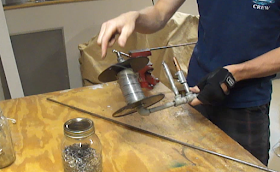Now, the basic principle here is to place a spool of wire on the device's arm so it feeds into the coil when spun. The rest of the pieces are for convenience and consistency. Below is the most basic schematic of the mechanism.
The spool goes on the top bit, feeding the wire down onto the bar. This design requires no fabrication and can be made solely out of pipe fittings found in any hardware store. Usually, I clamp the rod in a bench vice or to a table. If I am using a longer rod, I support the free end with a string from the ceiling so it does not fold from the weight.
To be most stable, the X pipe fitting that the bar slides through should have an inner diameter as close to the bar's outer diameter as possible. To make it more stable, another piece of pipe can be affixed to the left side.
Next is the design I actually use. It is a bit more complicated and requires a few simple tools to build. I substituted a T fitting for the X because it is cheaper and I can drill a hole closer to the bar's size for it to slide through on the left. On the right side in line with the bar I screwed a short (~3cm past threads) piece of pipe into the T. This allows me to clamp a bit of copper (or other ductile metal) pipe in place to act as a guide for the wire. A slit in the pipe lets the entire mechanism slide into place once the coil is started by hand.
The middle T piece with another extension on it is a guide for the guide. If that seems redundant, I thought so too. It was not in the prototype I made back in the day, but after using it a few times I noticed that the curvature in the spooled wire was enough to misalign it from the rod. By having a second guide arm in place, it forces the wire to enter the copper pipe at a constant angle and with minimal deflection. The slit in the middle pipe needs to go through both sides, where the copper needs only a single slice in the top.
In practise, it looks a little more messy, but it gets the job done. Here is an image of the one I built back in 2006.
The two washers are for when I use a 6" spool so it does not slide off the end of the pipe.
Because I buy 1/4 mile spools of wire at a time, that is a little too much to manage at once. The weight bends the bar, so I have to transfer it to a smaller spool for the winding. I take an arbitrary amount, but enough to spin a 5m coil at least. To do this, I take advantage of another feature of the design. I unscrew the copper pipe assembly and replace it with the topmost pipe (removing the middle entirely). Securing the smaller spool with a bit or wire or zip tie, I can slide that onto the bar and rotate the two handles fairly quickly.
Here is a clearer view of what it looks like in action. Keeping a constant force on the device towards the clamp will keep the coil tight against itself, helping make the rings more uniform.
For more info and a what it looks like in action, check out the video I made below.






No comments:
Post a Comment